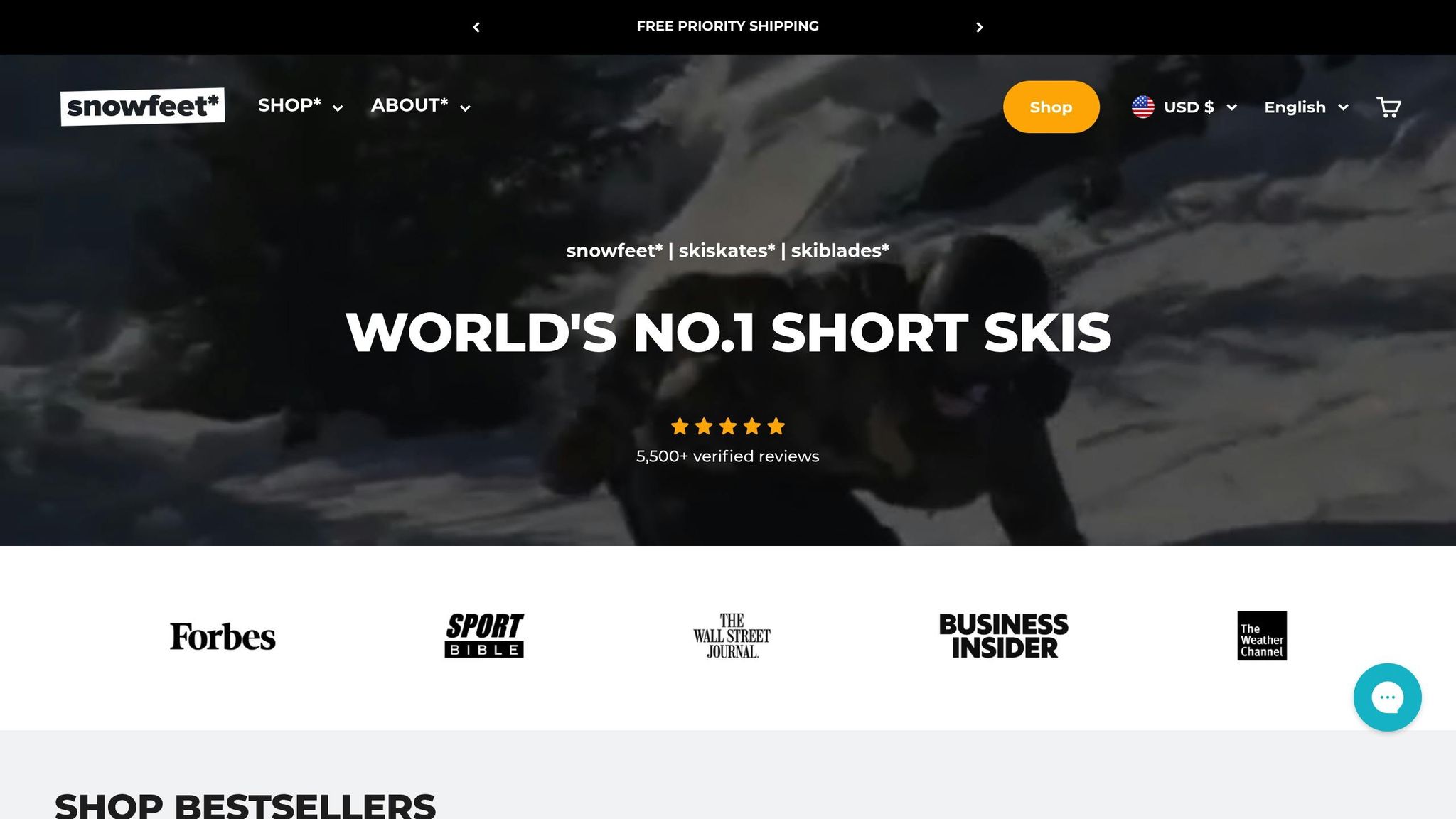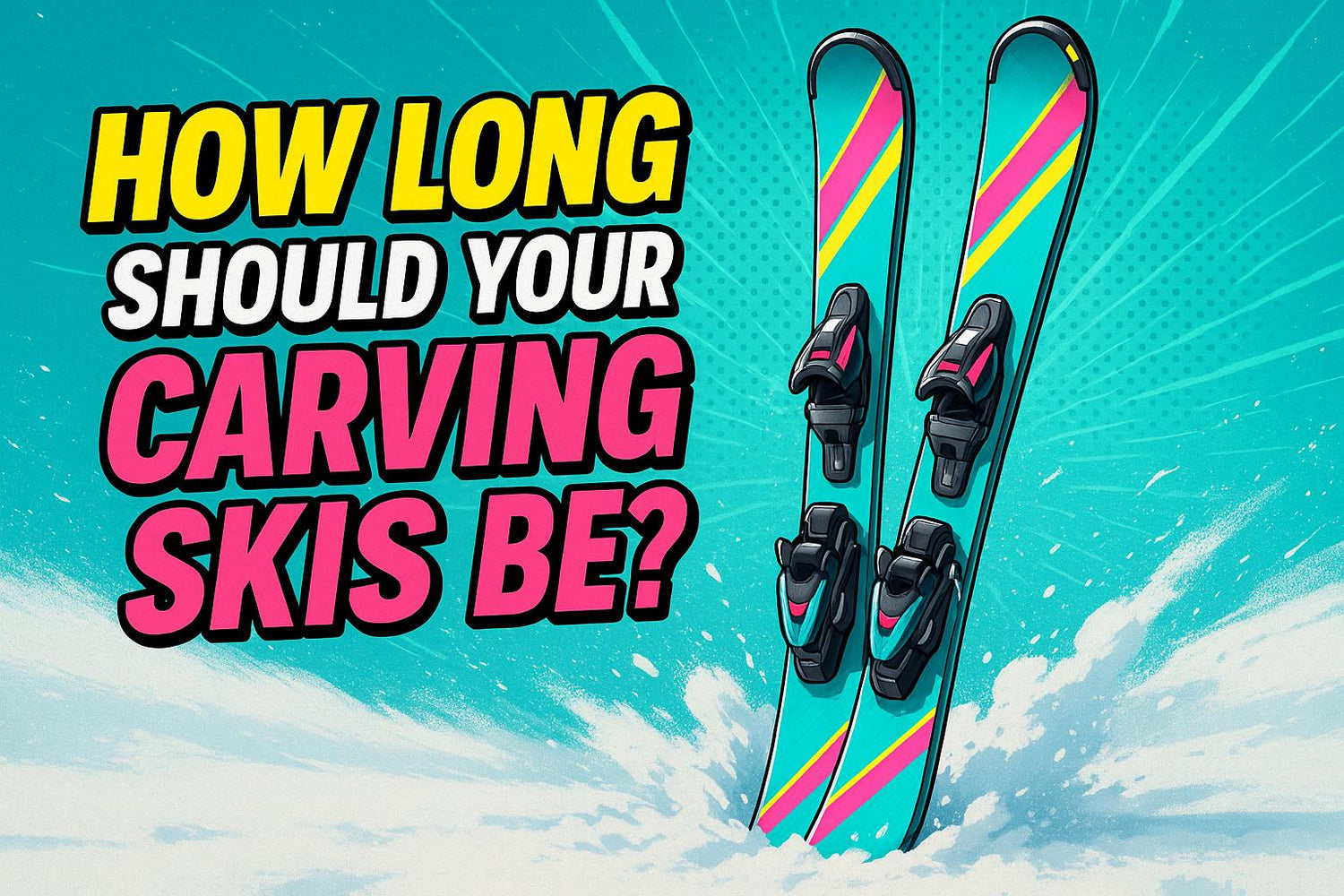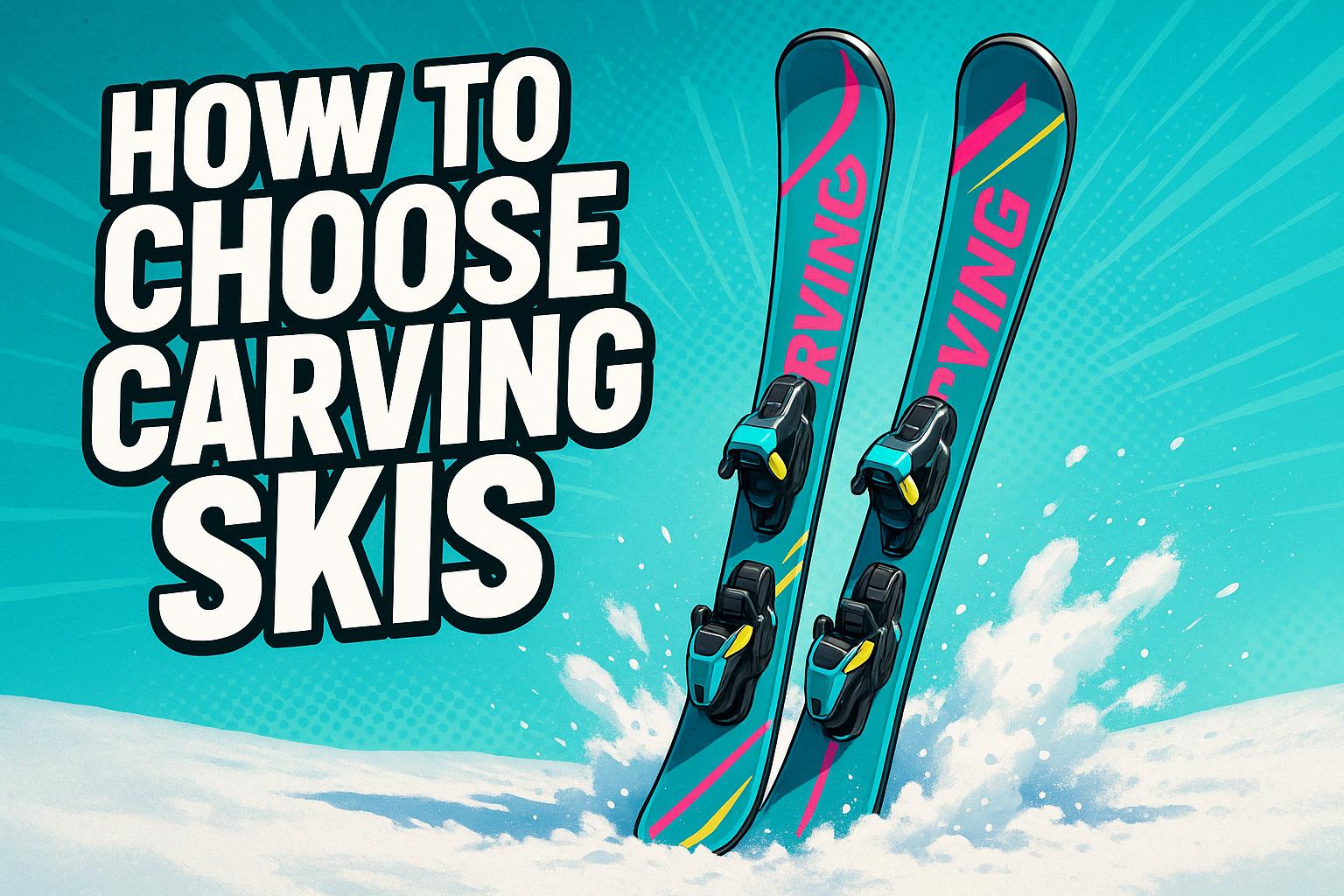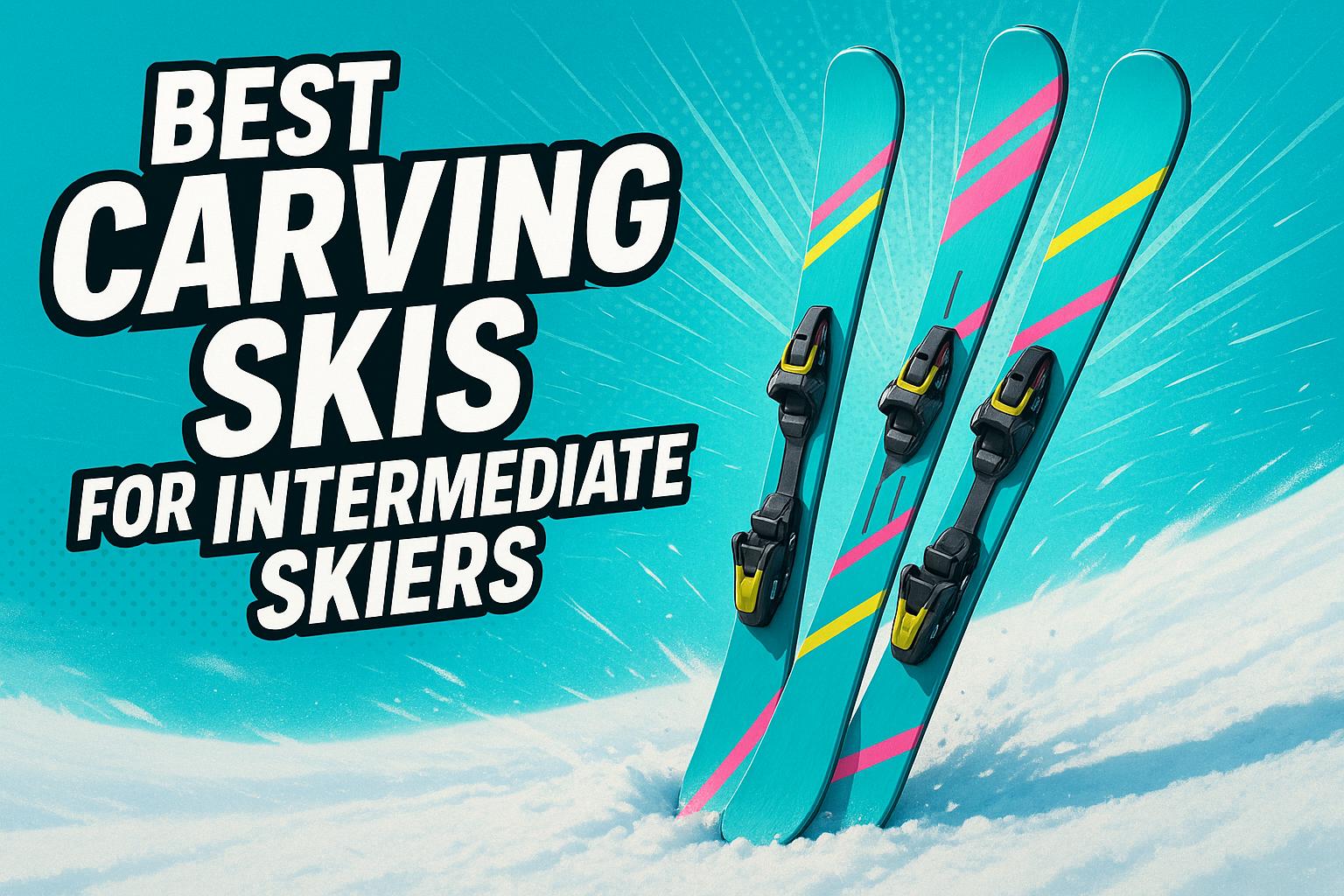Choosing the right ski length is all about matching your skis to your height, skill level, and skiing style. While the old rule of thumb was to pick skis that stand between your chin and nose, shorter skis are gaining traction for their ease of use and control. Short skis, like Snowfeet Skiblades, range from 65 cm to 120 cm and are perfect for beginners, freestyle enthusiasts, or anyone who wants a more playful experience on the slopes.
Here’s the quick takeaway:
- Short skis (65–120 cm): Easier to control, great for tight turns, terrain parks, moguls, and quick learning.
- Standard carving skis (150–190 cm): Offer stability at higher speeds, better for icy or hard-packed snow, and deep powder.
- Skill Level: Beginners do better with shorter skis, while advanced skiers might prefer longer skis for speed and stability.
Snowfeet Skiblades stand out for their portability, versatility, and fun factor. They’re lightweight, easy to transport, and work well across different terrains. Whether you’re a beginner or a seasoned skier, short skis can offer a refreshing way to enjoy the slopes.
Want the details? Keep reading to find out which ski length fits your style, skill, and goals.
Carving Ski Length Basics
Standard Ski Length Rules
The classic method for choosing ski length is pretty simple: stand the skis upright next to you, and they should reach somewhere between your chin and the top of your head. For instance, if you're 6 feet tall, you'll generally want skis that are between 170 and 190 cm long (about 67–75 inches).
Big names in the ski industry like Rossignol, Atomic, Elan, and Head base their sizing charts on this height-focused system. While taller skiers tend to need longer skis for better stability and control, your skill level also matters. Beginners often opt for shorter skis because they’re easier to handle and turn. On the other hand, longer skis have traditionally been favored for their stability at higher speeds and better grip on icy or hard-packed snow.
| Skier Height | Beginner Length (cm) | Intermediate Length (cm) | Expert Length (cm) |
|---|---|---|---|
| 4'6" (137 cm) | 125 | 135 | 140 |
| 5'0" (152 cm) | 140 | 150 | 155 |
| 5'4" (163 cm) | 150 | 160 | 170 |
| 5'8" (173 cm) | 160 | 170 | 180 |
| 6'0" (183 cm) | 170 | 180 | 190 |
| 6'4" (193 cm) | 180 | 190 | 200 |
However, trends in ski design are shaking up these traditional rules.
Short Skis Are Gaining Popularity
Skis under 160 cm are becoming a favorite for many skiers, and for good reason. They’re lighter, easier to control, and make quick turns a breeze. These features make them ideal for groomed trails, terrain parks, and moguls. Snowfeet* Skiblades are a great example of this trend, offering lengths of 65 cm (26 inches), 99 cm (39 inches), and 120 cm (47 inches) - far shorter than standard skis.
"Contrary to a wide-spread belief, short skis are in many cases better than long skis. They are suitable for a wider range of skiers than longer skis and they bring many more benefits on the slopes. Whether you are a beginner or a free-style lover, you will have a blast riding short skis."
– Snowfeet Team
With less ski underfoot, you get quicker transitions and more control, making short skis a fun and practical choice. While traditional brands like Head and Elan still cater to intermediate skiers with skis often over 180 cm, Snowfeet* proves that shorter designs can deliver better results for a broader range of users.
Short skis also come with added perks off the slopes. They’re easier to pack, transport, and store, which is a big plus for travelers. And if you’re just starting out, the manageable size helps you focus on improving your carving skills without wrestling with oversized gear. It’s a win-win for both convenience and progression.
How to Choose the Right Ski Length | Find the Perfect Ski Length
What to Consider When Choosing Ski Length
When it comes to picking the perfect ski length, it’s not just about following a chart. Your skill level, the terrain you ski on, and your style all play a big role in finding the right fit. Let’s break it down.
Your Skill Level
How experienced you are on the slopes is a big factor in choosing ski length. If you’re just starting out, shorter skis are the way to go. They’re easier to control and help you learn to turn without feeling overwhelmed. Long skis, on the other hand, can make things trickier and slow your progress.
For beginners, Snowfeet* Skiblades are a solid choice. Their shorter lengths - 65 cm (26 inches) or 99 cm (39 inches) - make it easier to focus on building good technique without battling your gear. As you gain confidence and improve, you might consider moving up to something like the Snowfeet* Short Skis at 120 cm (47 inches). Advanced skiers often prefer longer skis for stability at higher speeds and better grip on hard-packed snow, but even seasoned pros are starting to embrace shorter skis. Why? They’re super versatile and handle a variety of terrains and skiing styles with ease.
Where You Ski
The terrain you ski on is another key consideration. Groomed runs are pretty forgiving and work well with a range of ski lengths, whether you prefer short or long skis. But if you’re heading into deep powder, longer skis are a better bet. They give you more float, keeping you above the snow. Brands like Rossignol and Atomic even make powder skis that often exceed 180 cm for this very reason. That said, most recreational skiers stick to groomed trails, where shorter skis perform just fine.
Shorter skis really shine in places like terrain parks, moguls, tree runs, and steep, narrow trails. Quick turns are essential in these spots, and shorter skis make them a breeze. As ski patroller Jeff Rauland explains:
"On a groomed trail - not much. On deep powder, ungroomed terrain, or back-country? Well then your done!"
In other words, while shorter skis might not be as fast on groomed trails, their agility makes them unbeatable in tight spots like bumps and trees. Snowfeet* skis, with their compact design, excel in these scenarios, offering unmatched control and maneuverability.
How You Ski
Your personal skiing style should also guide your choice. If you’re into tricks and quick direction changes, shorter skis are your best friend. For example, a skier who’s 5'8" (173 cm) might go for skis in the 155–160 cm range for jibbing and rails. On the flip side, if you’re all about big jumps, halfpipes, or high-speed runs, longer skis provide the stability you need for smooth landings and control.
For all-mountain freestyle skiing - a mix of park features and groomed slopes - skis that are about 2 inches shorter than your height strike the right balance between control and stability.
Here’s a quick guide to ski lengths based on style and height:
| Skiing Style | 5'4" Skier | 5'8" Skier | 6'0" Skier |
|---|---|---|---|
| Jibbing/Rails | 57–59 inches | 61–63 inches | 65–67 inches |
| Jumps | 61–63 inches | 65–67 inches | 69–71 inches |
| All-Mountain | 59–61 inches | 63–65 inches | 67–69 inches |
With options ranging from 65 cm to 120 cm, shorter skis offer a fun, controlled ride. Their compact size makes them easy to carry, perfect for quick turns, and ideal for focusing on technique - all while keeping the fun factor high.
Short Skis vs Standard Carving Skis: Side-by-Side Comparison
Let’s break down the differences between Snowfeet* Skiblades and traditional carving skis from well-known brands like Rossignol, Atomic, Elan, and Head. While both are designed for fun on the slopes, their construction and features set them apart.
Traditional skis, such as those from Atomic or Head, typically use wood cores, which are known for their durability and performance. Snowfeet*, on the other hand, offers two options: a basic model made from tough plastic and a premium version with a wood core and cap construction. Despite their compact size, Snowfeet* Skiblades deliver performance comparable to traditional skis.
One of the standout features of Snowfeet* Skiblades is their versatility. Unlike standard carving skis, which are primarily built for downhill skiing, Snowfeet* Skiblades let you combine skiing with skating motions. This flexibility opens up opportunities for different skiing styles that traditional skis can’t easily accommodate.
Feature Comparison Chart
Here’s a quick look at how Snowfeet* Skiblades compare to traditional carving skis:
| Feature | Snowfeet* Skiblades | Traditional Carving Skis |
|---|---|---|
| Length Range | 65–120 cm (26–47 inches) | 150–180 cm (59–71 inches) |
| Weight | Ultra-light; fits in a backpack | Heavier; needs a ski bag or rack |
| Boot Compatibility | Works with ski and snowboard boots | Designed for ski boots only |
| Learning Curve | Quick and easy | Steeper; often requires lessons |
| Portability | Extremely portable | Bulky and harder to transport |
| Terrain Versatility | Great for groomed runs, parks, moguls, and trees | Best for groomed runs only |
| Movement Style | Allows skiing and skiskating | Built for downhill skiing |
| Storage | Minimal space needed | Requires more storage space |
| Price Range | $450–$690 | $400–$1,200+ |
| Maintenance | Simple, low-effort upkeep | More complex tuning needed |
Transporting Snowfeet* Skiblades is a breeze compared to traditional skis. They’re small enough to fit in a regular backpack, meaning no need for roof racks or ski bags. You can even bring them as carry-on luggage when flying or easily stow them in your car. This portability also makes them perfect for hiking to remote spots where lugging full-length skis would be a hassle.
While traditional carving skis shine on groomed runs and in deep powder, Snowfeet* Skiblades are all about convenience and fun. They’re great for beginners, thanks to their easy learning curve, but they also offer the agility that experienced skiers will enjoy. For recreational skiers looking for a no-fuss option, Snowfeet* Skiblades are a game-changer.
sbb-itb-17ade95
Why Snowfeet* Skiblades Are Your Best Option

When you compare traditional carving skis to Snowfeet* Skiblades, it’s easy to see why these compact skis are shaking things up on the slopes. With their unique design and versatility, they offer a fresh take on carving. Whether you’re a beginner or just looking to mix things up, Snowfeet* Skiblades provide benefits that bigger names like Rossignol and Atomic can’t quite match. Let’s dive into how their clever design makes life on the mountain easier.
Smart Design and Easy Access
Snowfeet* Skiblades are all about convenience. Their small size means you can toss them in a regular backpack - no need for bulky ski bags or special carriers. This portability makes heading to the mountain a breeze, skipping the usual hassle of lugging around long, awkward skis.
"With these little skis, you feel much more agile, faster, and above all – comfortable. No buckles, no heavy boots – just strap in and go."
- Jakub F
Another big win? The learning curve. Unlike traditional skis from brands like Head or Elan, which often demand multiple lessons and lots of practice, Snowfeet* Skiblades are designed to help you gain control and confidence quickly. It’s skiing made simple.
Works on Multiple Terrains
Traditional carving skis might shine on groomed runs, but Snowfeet* Skiblades open up a wider range of possibilities. Their 65 cm model is perfect for groomed snow and excels on narrow hiking trails where longer skis would be a nightmare. Powder fans will appreciate the 99 cm version, which handles snow up to about 4 inches deep with ease. And for those who want an all-around option, the 120 cm Short Skis can tackle everything from slopes and moguls to snowparks and powder.
Thanks to their metal edges, these skiblades offer solid stopping power, even in terrain parks. Regular waxing keeps the base smooth and prevents snow from sticking, ensuring a better glide. With this kind of versatility, every run feels like an adventure.
More Fun on the Mountain
Snowfeet* Skiblades are all about making skiing fun and approachable. Traditional carving skis can feel technical and a bit intimidating, but the agility of these shorter skis encourages a playful, experimental vibe. Whether you’re carving, trying tricks, or navigating tight spaces, their easy handling lets you enjoy the mountain in a whole new way.
Plus, their lightweight design means less fatigue, so you can keep going longer without feeling worn out. For casual skiers who prioritize fun and variety over the steep learning curve of traditional skis, Snowfeet* Skiblades are a game-changer.
Product Recommendations for Different Needs
Let’s dive into which Snowfeet* Skiblades are best suited for your skill level and preferences. Whether you’re just starting out or you’re a seasoned pro, there’s a model designed to enhance your time on the slopes.
Snowfeet* Skiblades 65 cm
If you’re new to skiing, the 65 cm Skiblades are a fantastic starting point. Priced from $450.00, these compact skis are all about control and ease of use. Their shorter length makes learning smoother and turning much easier. With a softer flex, they reduce the chances of falling and help build confidence. The wider waist adds extra stability, and the included bindings are compatible with both ski and snowboard boots - talk about convenience!
Snowfeet* Skiblades 99 cm
For those with some experience under their belt, the 99 cm Skiblades are a great step up. Starting at $490.00, these skis strike a balance between stability and agility. They’re perfect for carving through mixed terrain and cruising down moderate slopes. Plus, they’re lighter than traditional intermediate skis, making them ideal for quick runs and all-mountain adventures.
Snowfeet* Short Skis 120 cm
Advanced skiers, this one’s for you. The 120 cm Short Skis are built for tackling tough terrain, from steep slopes to powder, and they shine during high-speed runs. At $690.00, they’re designed for those who crave speed and precision. If you’re all about performance and pushing your limits, these skis won’t disappoint.
Here’s a quick comparison to help you decide:
| Skiblade Length | Best For | Terrain | Price |
|---|---|---|---|
| 65 cm Skiblades | Beginners, easy turns | Gentle slopes, tight spaces | From $450.00 |
| 99 cm Skiblades | Intermediate skiers, versatile ride | Mixed terrain, moderate slopes | From $490.00 |
| 120 cm Short Skis | Advanced skiers, speed and performance | Steep slopes, powder, high-speed runs | $690.00 |
Conclusion: Pick the Right Ski Length with Snowfeet*
Finding the right ski length doesn’t have to be complicated. While big-name brands like Rossignol, Atomic, and Head continue to focus on longer skis, Snowfeet* is proving that shorter skis can offer unmatched agility. Whether you’re just starting out or you’ve been skiing for years, there’s a Snowfeet* model designed with you in mind.
What makes Snowfeet* Skiblades stand out is their flexibility and ease of use. Unlike traditional long skis, which are mainly built for groomed slopes, these shorter skis let you explore beyond the usual terrain. You can carve turns on the slopes or navigate narrow hiking trails with ease. They perform exceptionally well on groomed snow, making them a versatile option for any skiing style.
Snowfeet* offers three models to suit different preferences:
- 65 cm Skiblades: Perfect for quick turns and tricks, offering maximum agility.
- 99 cm Skiblades: A great middle ground, balancing control and stability.
- 120 cm Short Skis: Ideal for advanced skiers who want the feel of traditional skiing but with more freedom.
Short skis from Snowfeet* deliver a level of agility and responsiveness that traditional long skis just can’t match. You’ll enjoy instant reactions, easier stops, and the ability to try tricks whenever you feel like it. The metal edges provide solid grip, just like traditional skis, and the compatibility with snowboard bindings adds to their comfort and adaptability. Plus, their lightweight design means you’ll have more stamina for longer days on the mountain.
Ready to change the way you ski? With prices starting at $450 for the 65 cm model and going up to $690 for the 120 cm version, Snowfeet* combines performance, freedom, and fun in every model. It’s time to experience skiing in a whole new way.
FAQs
What’s the right carving ski length for your height and skill level?
Choosing the right ski length comes down to your height, skill level, and how you like to ski. As a rule of thumb, skis should fall somewhere between your chin and the top of your head. Beginners usually go for shorter skis - closer to chin height - because they’re easier to control. On the other hand, seasoned skiers might pick skis slightly taller than their head for added stability and performance. For instance, if you’re 6 feet tall, you’d likely choose skis between 67 and 75 inches (170-190 cm), depending on your experience and the type of terrain you enjoy.
If you’re after something more compact and versatile, Snowfeet* carving skis are worth considering. Their shorter skiblades, available in lengths like 65 cm, 99 cm, or 120 cm, offer a lightweight and easy-to-handle alternative to traditional skis from brands like Atomic or Head. These shorter skis are great for beginners or anyone who wants a fun, playful ride without sacrificing performance.
Why choose Snowfeet Skiblades instead of traditional carving skis?
Snowfeet Skiblades bring a fresh twist to skiing with their shorter length (anywhere from 25 to 47 inches), lightweight build, and impressive agility. These qualities make them a breeze to handle - perfect for beginners finding their footing or casual skiers looking for something easy and fun. Plus, they’re great for quick turns, pulling off tricks, or zipping through tight spots.
Unlike traditional skis, which are often bulky and built for speed and stability, Snowfeet Skiblades are all about fun, flexibility, and simplicity. You can use them on slopes, in parks, or even on trails. Their compact size is a game-changer, too - no need for a roof rack or extra storage space. Whether you’re after a playful day in the snow or just want a more manageable option than long skis, Snowfeet Skiblades offer convenience and a whole lot of fun.
Are Snowfeet Skiblades suitable for all types of terrain?
Snowfeet Skiblades are built to handle all kinds of terrains - groomed slopes, moguls, snow parks, and even powder. Thanks to their compact size and lightweight build, they’re super easy to control, especially in tight spots or uneven conditions.
Unlike traditional skis, which can be bulky and often specialized for things like deep snow or high-speed runs, Snowfeet Skiblades strike a great balance between control and flexibility. Their parabolic shape and extra width give you solid stability and help you float through powder with ease. Whether you’re carving up the groomers or exploring mixed terrain, these skiblades bring a playful, practical twist to skiing for anyone, no matter your skill level.


































Leave a comment
This site is protected by hCaptcha and the hCaptcha Privacy Policy and Terms of Service apply.